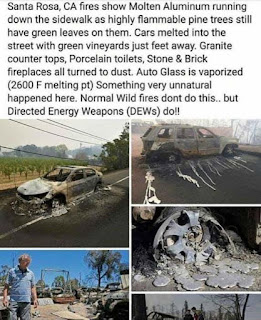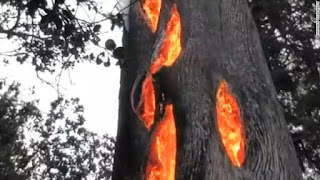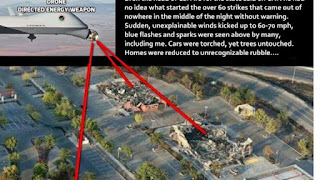 A warning to northern First Nations - guard your land and watch out for new fires this year. Pray to Creator for an abundance of rain this summer, and perform ceremonies that bring rain. Those in power may use DEW lasers that were used in the California fires to force people to evacuate land, including deliberate human-caused fires. The California fires were a deliberate land grab, and also conveniently used after the Australia fires, where the train line was being built. If you're not sure what DEW is, just do a Google image search of "california fires DEW laser" and look at the obvious damage done.
A warning to northern First Nations - guard your land and watch out for new fires this year. Pray to Creator for an abundance of rain this summer, and perform ceremonies that bring rain. Those in power may use DEW lasers that were used in the California fires to force people to evacuate land, including deliberate human-caused fires. The California fires were a deliberate land grab, and also conveniently used after the Australia fires, where the train line was being built. If you're not sure what DEW is, just do a Google image search of "california fires DEW laser" and look at the obvious damage done.
First Nations in Western BC and across Canada are all united and stand together for a very important matter: OPPOSING the Northern Gateway Pipeline and its corruption ... that are partnered with PetroChina and others, who Canada plans on selling to in our GLOBAL economy. There were numerous protests in Canada against the pipeline that were taking place just before the official quarantine was announced - but new COVID19 regulations have conveniently made it hard to organize protests. Alberta’s energy minister says it’s a good time to build the pipeline because public health restrictions limit protests against them - how convenient.
Take note that communities from Bella Coola, Kitimat, and elsewhere are actively involved in standing against this pipeline development that will be passing through First Nations land. Now read some of the headlines below ...
A Bella Coola Harbour landmark has been destroyed by a fire police believe was deliberately set. The BC Packers building known as the Old Cannery was consumed by the blaze which occurred just before midnight Thursday night, June 27.Jun 29, 2019
Between June 10, 2018 and Sept. 2, 2018, there have been four separate suspicious fires on Bella Coola Nuxalk Nation lands; a home in the 900 block of Four Mile, an abandoned trailer in the 800 Block of Four Mile, gas cans set on fire near an apartment in Four Mile as well as a home in the 800 Block of Snuqaax Mamnta have all been the scenes of fire.
“We believe these fires were deliberately set,” said Sgt Rick Skolrood, RCMP NCO In Charge of the Bella Coola detachment.
“No one’s been harmed but there is always a potential so we are taking it very seriously.”
Apr 5, 2012 - The Nuxalk First Nation of Bella Coola announced Thursday it is pulling ... handling of recent hearings in the neighbouring community of Bella Bella. ... after the Heiltsuk Tribal Council greeted panel members with a protest.




















